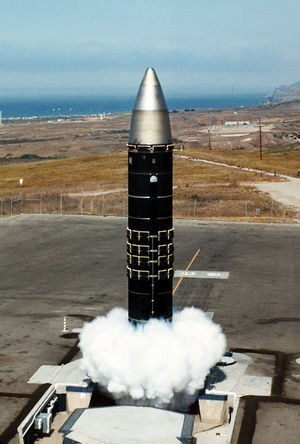LGM-118 Peacekeeper
| LGM-118A Peacekeeper | |
|---|---|
 Test launch of a Peacekeeper ICBM by the 1st Strategic Aerospace Division (1 STRAD), Vandenberg AFB, CA (USAF) |
|
| Type | Intercontinental ballistic missile |
| Service history | |
| In service | 1986 |
| Production history | |
| Manufacturer | Boeing, Martin Marietta, TRW, and the Denver Aerospace company |
| Unit cost | approximately $70 million |
| Specifications | |
| Weight | 96.75 tons |
| Length | 71 ft 6 in (21.8 m) |
| Diameter | 7 ft 7 in (2.3 m) |
|
|
|
| Warhead | up to 10 Avco Mk-21 re-entry vehicles each carrying a 300 KT (1.25 PJ) W87 warhead. (The Combined Explosive power of the MIRV for one ICBM is 3000 KT) |
| Detonation mechanism |
Airburst |
|
|
|
| Engine | * First Stage: 500,000 lbf (2.2 MN thrust) Thiokol SR118 solid fuel motor;
|
| Operational range |
5,200 nmi (9,600 km; 6,000 mi) |
| Guidance system |
Inertial (AIRS) |
| Accuracy | 393 ft 7 in (120 m) CEP |
| Launch platform |
Fixed silo |
The LGM-118A Peacekeeper, also known as the MX missile (for Missile-eXperimental), was a land-based ICBM deployed by the United States starting in 1986. A total of 50 missiles were deployed. They have since been deactivated.
Under the START II treaty, which never entered into force, the missiles were to be removed from the U.S. nuclear arsenal in 2005, leaving the LGM-30 Minuteman as the only type of land-based ICBM in the U.S. arsenal. Despite the demise of the START II treaty, the last of the LGM-118A "Peacekeeper" ICBMs (but not their warheads) were decommissioned on September 19, 2005. Current plans are to switch 500 decommissioned Peacekeepers' W87/Mk-21 warheads to the Minuteman III.[1] Among the reasons cited for decommissioning of the Peacekeeper ICBM was its failure to achieve the program's range objectives.[2]
The Peacekeeper was a MIRV missile; the MX could carry up to 10 re-entry vehicles, each armed with a 300-kiloton W87 warhead/MK-21 RVs (twenty times the power of the bomb dropped on Hiroshima during World War II.[3])
Contents |
Development and deployment

During the late 1970s, the Soviet Union fielded a large number of heavy, increasingly accurate, MIRV ICBMs (like the SS-18, defined by throw weight) which seriously threatened the survival of Minuteman III missiles in their silos. If the Soviet Union could have knocked out the majority of these missiles and the strategic bombers on ground, it would have left the United States with no counterforce capability for the second strike. The Poseidon and Trident I SLBMs were not accurate enough for counterforce strikes, and did not carry high enough yield. If the Soviet first strike would have avoided hitting civil targets, the US might have been forced not to retaliate against Soviet cities, because of similar Soviet countercity capabilities. So the United States needed weapons which could survive a Soviet first-strike and neutralize the remaining Soviet strategic arsenal, in order to avoid nuclear blackmail. However it was clear from the outset that this missile would be unable to neutralize at least the part of the Soviet strategic arsenal located on nuclear ballistic missile submarines on patrol.
Still, the development of the Peacekeeper began with the intent of its being a counterforce, hard-target weapon. It was to be aimed at hardened enemy missile silos with first-strike capability. This required high accuracy, survivability, range and a flexibility that was not available in the Minuteman III.
Accuracy was an especially important issue, since the effects of the blast and heat from a thermonuclear detonation decrease very rapidly with distance from the impact point. The targets were hardened Soviet ICBM-silos, especially those housing the heavy SS-18, which were targeted at Minuteman missile silos.

Design work on the MX began in 1972. In 1976, Congress refused to fund a silo-based system on grounds of vulnerability and the project was halted until 1979 when President Carter authorized development of a system of multiple protective shelters linked by underground roads, the so called "Racetrack" proposal. President Reagan canceled the new shelter system calling it "a Rube Goldberg scheme", in 1981 and pushed for a "dense pack" solution to speed deployment. This "dense pack" idea involved building super-hardened silos that would withstand more than 10,000 psi (70 MPa) of overpressure and spacing them only 1,800 feet (550 m) apart. The reasoning behind this idea was that a nearby nuclear explosion would damage other incoming warheads in the same wave of attack and would allow a substantial portion of the missiles to survive. This "fratricide theory" was fundamentally flawed due to the relative ease with which the Soviets could modify their warheads and circumvent this design. Congress again rejected the silo-based system.
A compromise was developed in mid-1983, by which there would be swift deployment of 100 new missiles in existing Minuteman silos to show "national will", the removal of the venerable and accident-prone liquid fueled Titan II ICBM from use, and the later introduction of a new more mobile single-warhead ICBM (the Midgetman).

The new ICBM missile was originally planned to be called "Peacemaker", but at the last minute was officially designated the LGM-118A Peacekeeper. It was first test fired on June 17, 1983, by the Air Force Systems Command Ballistic Missile Office (Norton AFB, CA); 6595th Missile Test Group (Vandenberg AFB, CA); and Martin Marietta, from Vandenberg AFB, California Test Pad-01, traveling 4,200 nautical miles (4,800 mi; 7,800 km) to strike successfully in the Kwajalein Test Range in the Pacific. The first eight test flights were launched from an above ground cannister on TP-01, with the remaining test and operational Strategic Air Command flights from silos (LF-02, -05, & -08) all located on North Vandenberg AFB. A total of 50 flight tests were accomplished. The operational missile was first manufactured in February 1984 and was deployed in December 1986 to the Strategic Air Command, 90th Strategic Missile Wing at the Francis E. Warren Air Force Base in Wyoming in re-fitted Minuteman silos. Fifty working missiles had been deployed at F.E. Warren AFB by December 1988. The planned deployment of one hundred missiles was canceled by the U.S. Congress in July 1985, again over the theoretical survivability issue. In that decision, Congress limited the deployment of Peacekeeper ICBMs to 50 missiles until a more "survivable" basing plan could be developed.
The survivability problem was to be solved by a "rail garrison" system whereby 25 trains, each with two missiles, would use the national railroad system to conceal themselves. It was intended that this system would become operational in late 1992, but budgetary constraints and the collapse of the Soviet Union led to its being scrapped.
The project had already cost around $20 billion up to 1998 and produced 114 missiles, at $400 million for each operational missile. The "flyaway" cost of each missile was estimated at 20 to 70 million dollars. The total combined firepower for all 114 ICBMs was rated at around 342 megatons, or 342 million tons of TNT.
Retirement and deactivation
The missiles were gradually retired, with 17 withdrawn during 2003, leaving 29 missiles on alert at the beginning of 2004. At the start of 2005 only 10 remained on alert, scheduled to be retired by the end of the year. The last Peacekeeper was removed from alert on September 19, 2005 during the final deactivation ceremony when the 400th Missile Squadron was deactivated as well.[4] The Peacekeeper rockets are being converted to the satellite launcher role by Orbital Sciences, as the Minotaur IV (OSP-2), while their warheads will be deployed on the existing Minuteman III missiles. Parts of the missile are reused for the Ares rocket, in the 'Roll Control System' (RoCS).
Operator
- The United States Air Force was the only operator of the Peacekeeper.
- 400th Strategic Missile (later Missile) Squadron, Francis E. Warren AFB, Wyoming (1987-2005)
- Orbital Sciences: Will use the Minotaur IV civilian launch platform version.
See also
- Missile
- List of missiles
- Strategic Air Command
- Peace through strength
References
- ↑ The Peacekeeper (MX) ICBM
- ↑ The Peacekeeper (MX) ICBM
- ↑ Malik, John (September 1985). "The Yields of the Hiroshima and Nagasaki Nuclear Explosions" (PDF). Los Alamos National Laboratory. http://www.nuclearpathways.org/Docs/pdfs/00313791.pdf. Retrieved 2007-09-05.
- ↑ Edwards, Joshua S. (2005-09-20). "Peacekeeper missile mission ends during ceremony". United States Air Force. http://www.af.mil/news/story.asp?storyID=123011845. Retrieved 2009-05-28.
- "The Politics of Armageddon: The Scowcroft Commission and the MX Missile," in Kenneth Kitts, Presidential Commissions and National Security (Boulder: Lynne Rienner Publishers, 2006).
External links
|
|||||||||||||||||